Asus RT-AX86U Pro, Tested and Reviewed
For the price, you can’t find a gaming-specific Wi-Fi 6 router that beats the Asus RT-AX86U Pro.

The Asus RT-AX86U Pro is the next installment in a line of revered routers. The previous Asus RT-AX86U router received rave reviews from tech experts and gaming enthusiasts alike, but does the Asus RT-AX86U Pro still stand up to the current Wi-Fi 6 router competition? We got hands-on with the latest iteration in the Asus RT-AX86 series to answer that. From checking the specs to comparing it to similar routers, we set up and tested the Asus RT-AX86U Pro and reached a verdict based on its specs, setup, price, performance, and value.
What we liked
- Exceptional performance in testing
- Customizable modes to prioritize traffic
- Built-in filtering and VPN safety features
What we didn't like
- Design lacks universal appeal
- Somewhat involved setup
BroadbandNow Bottom Line
With so many Wi-Fi 6 router options, the Asus RT-AX86U Pro stands out from the crowd due to its exceptional performance, extra gaming features, and enhanced security. Whether you’re a gamer or you’re looking for an excellent all-around router, the Asus RT-AX86U Pro delivers tremendous value for a router costing only $151.99 at Amazon.
Our Asus RT-AX86U Pro Video Review
Would you rather watch a video of this review than read the entire deep dive? No problem! Check out our video review of the Asus RT-AX86U Pro below:
Walking Through Our Asus RT-AX86U Pro Experience
- Asus RT-AX86U Pro Specs
- Asus RT-AX86U Pro at First Glance: Better, Faster, Cheaper
- Asus RT-AX86U Pro Installation: Mostly a Breeze
- Asus RT-AX86U Pro Performance: Impressive Real-World Results
- Our Verdict: Ideal for Gamers and Everyday Users Alike
Asus RT-AX86U Pro Specs
| Details | Asus RT-AX86U Pro |
|---|---|
| Price | $151.99 at Amazon |
| Wi-Fi type | Wi-Fi 6 (802.11ax) |
| Number of radios | 2: dual-band |
| Speed rating | AX5700 |
| Wireless speeds | Up to 5,700 Mbps (combined frequencies) |
| Parental controls | Yes |
| Radio frequencies | 2.4GHz: 3×3; 5GHz: 4×4 |
| Security | AiProtection, WPA3-Personal, WPA2-Personal, WPA-Personal, WPA-Enterprise, WPA2-Enterprise, WPS support, Let’s Encrypt, DNS-over-TLS, SSH, Security Scan, and Firewall |
| Ports | WAN (1), LAN (4), 2.5 Gbps WAN/LAN (1), USB 3.2 Gen1 (1), and USB 2.0 (1) |
| Processor, memory, and storage | 2.0 GHz quad-core processor, 256 MB flash storage, and 1 GB RAM |
| Dimensions | 9.53 by 3.94 by 12.8 inches |
Asus RT-AX86U Pro at First Glance: Better, Faster, Cheaper
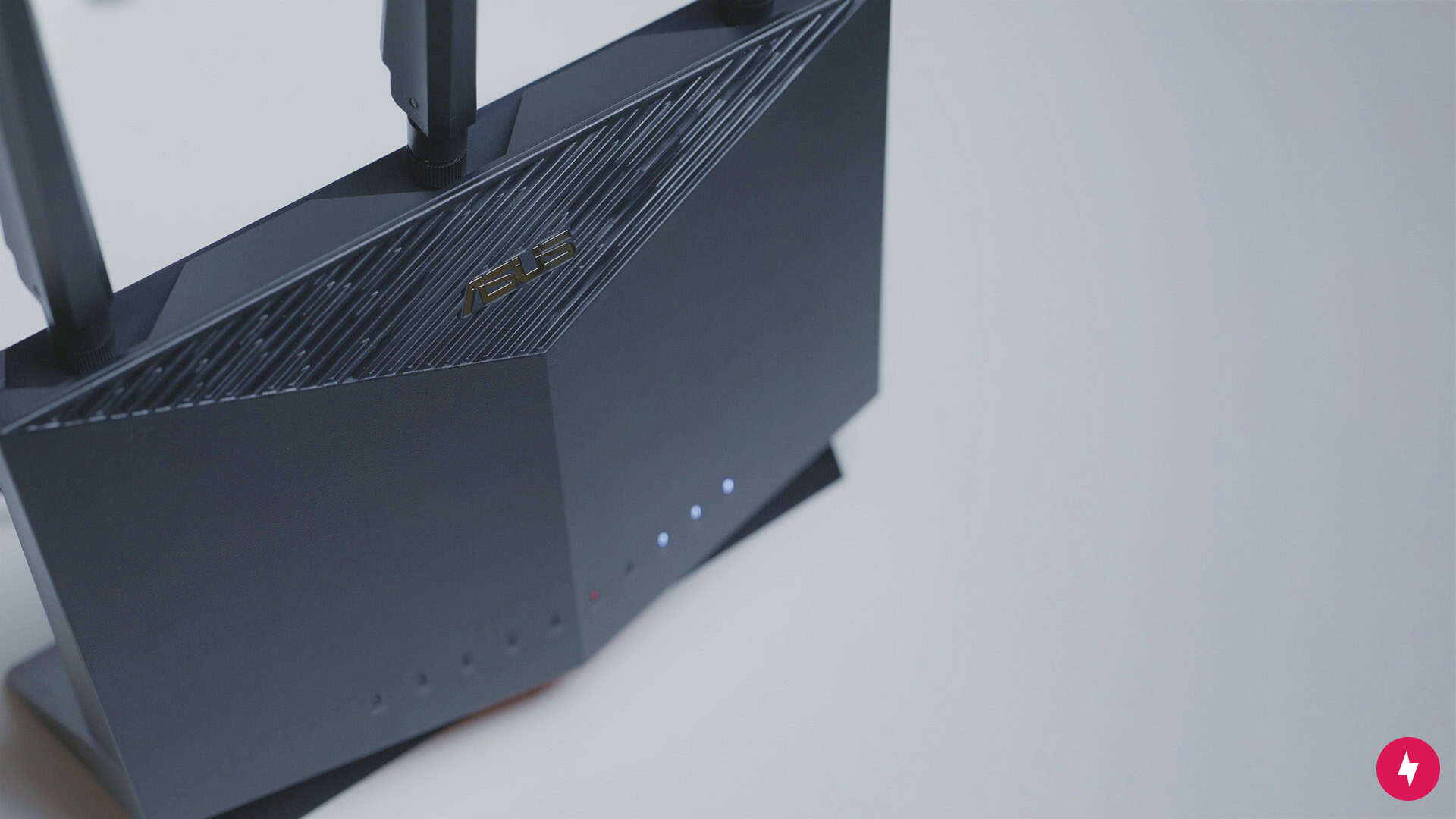
As a gamer who has purchased his fair share of Asus laptops, handheld consoles, and PC parts (don’t ask me how many), I know the company makes quality products. But I was curious if this gaming heritage would translate to the world of Wi-Fi routers. After getting hands-on with the Asus RT-AX86U Pro, I now know Asus can gamify just about anything.
Riding on the widespread success of its predecessor (RT-AX86U), the RT-AX86U Pro is a successor worthy of its new “Pro” moniker. Adopting the same standing posture and gamer-aesthetic thin, red strip on its underside, the RT-AX86U Pro has many of the same features as the RT-AX86U, including Wi-Fi 6 technology, AX5700 speeds up to 5,700 Mbps, 160 MHz channels, AiMesh integration, and a dedicated 2.5 Gbps LAN port. It’s not a carbon copy by any means though.

The Asus RT-AX86U Pro takes the router series to the next level by introducing a much faster 2.0 GHz quad-core processor, more flash and on-board RAM capabilities, expanded coverage through Asus RangeBoost Plus, and enhanced privacy and security features (compare each model head to head here). The Asus RT-AX86U Pro also comes with a dedicated Mobile Game Mode and Gear Accelerator for mobile gamers interested in getting the most out of their connection.
The kicker (and don’t ask us why): The RT-AX86U Pro comes in at a lower price than the previous version. It hovers around $200, while the older models tend to go for much more. Maybe the newer boards are cheaper to manufacture, or perhaps Asus wants to highlight the better model. Either way, its features and price changes put the entry-level gaming router in direct competition with more expensive models, such as the Netgear Nighthawk XR1000 and the Linksys Hydra Pro 6.
For the money, there’s not much more I could ask for from the router. Not only is it far better than my current Netgear Nighthawk RAX43 (which is more expensive, by the way), but it’s also easier to set up and use. At first glance, the Asus RT-AX86U Pro delivered as both an appealing gaming router and an all-around router for even casual users.
Asus RT-AX86U Pro Installation: Mostly a Breeze
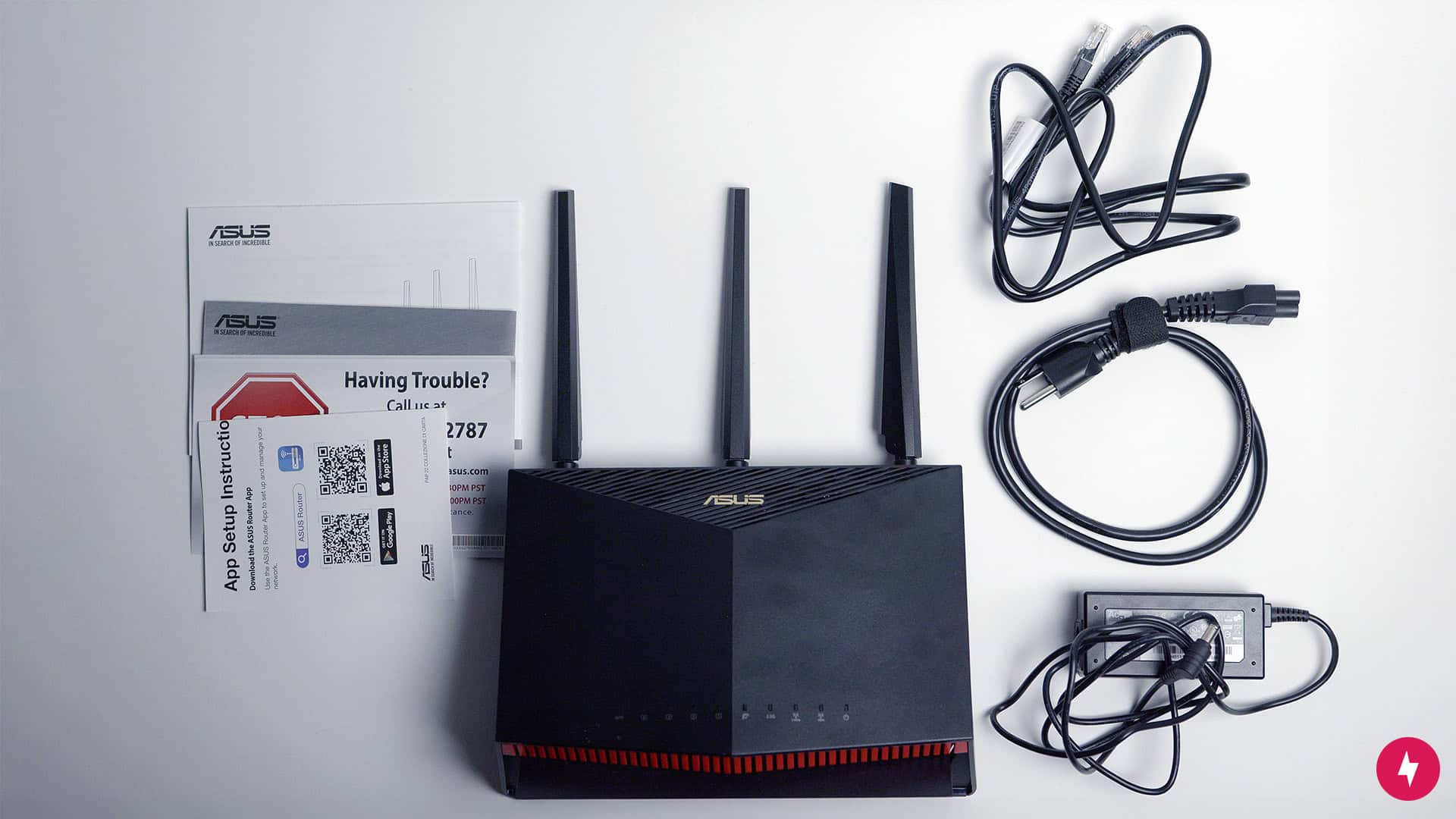
When it comes to setup, it may take you longer to pronounce Asus RT-AX86U Pro than it does to install the router. It didn’t have the super-fast setup of the eero Pro 6 we tested previously, but its quick-scan QR code, clear customization, and modern mobile app made installing and configuring the router a breeze.
Unboxing and Initial Setup
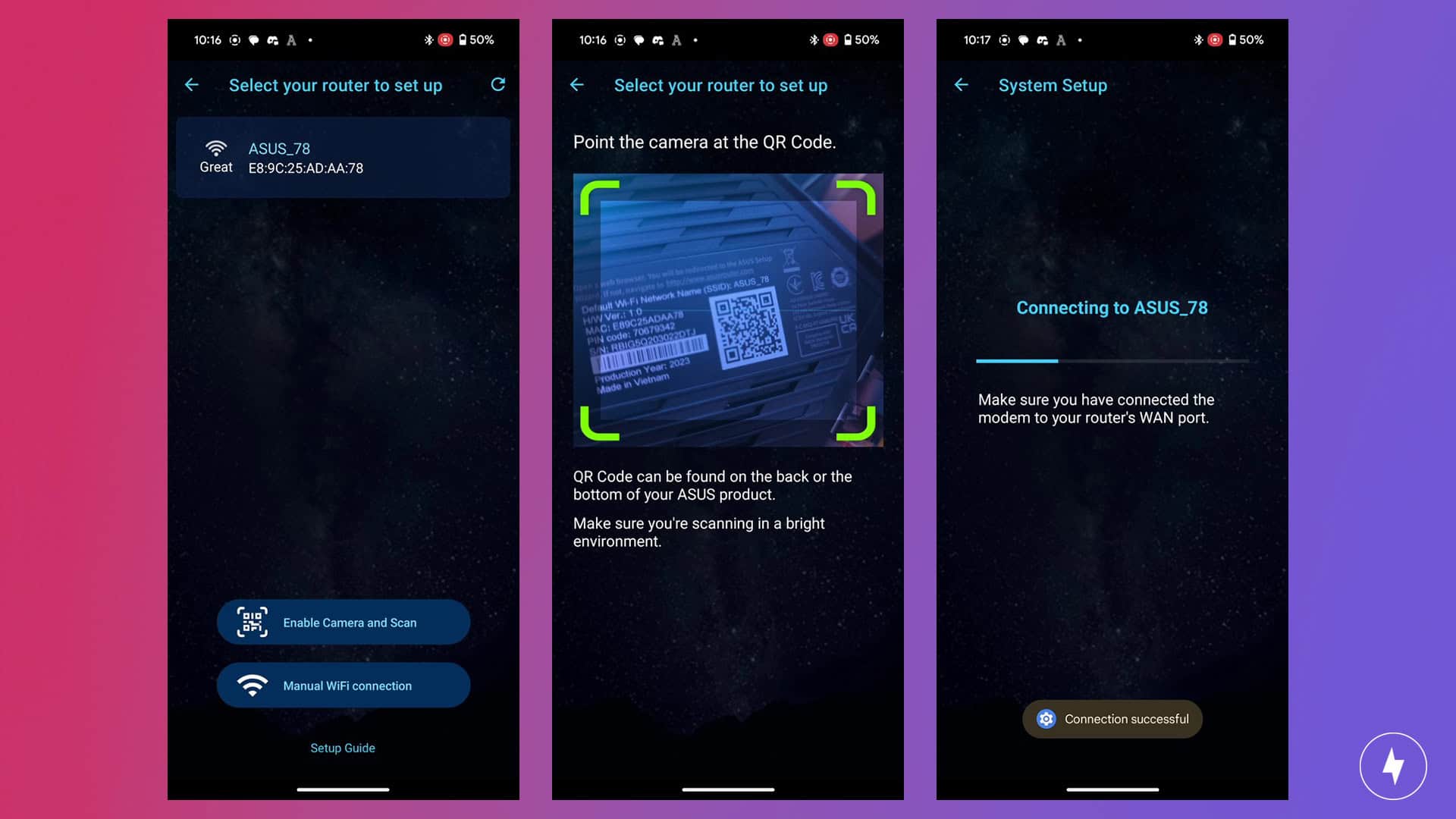
Straight out of the box, the Asus RT-AX86U Pro has everything you need: setup instructions (app, quick setup, and general), a power cord, an Ethernet cord, the router base, and three antennas. I appreciated how the router didn’t need much assembly. Simply plug in the power cord, hook up the Ethernet cord to your modem, add the three antennas, and you’re ready to go. One of my favorite things about setting up the router was the three antennas, because most gaming routers — I’m looking at you ROG Rapture GT-AXE11000 — have a ridiculous number of antennas that I’m not even sure add to the wireless connection and make the router look like an electronic centipede.
Once I positioned my router in the center of my living room, where I keep all my favorite gaming devices, I flipped on the router’s conveniently located power switch to start the setup process. I admit that I was slightly thrown off by the green 2.5G port (which means 2.5 gigabit) beside the WAN port, but I learned quickly after checking the documentation that you can configure the port for either WAN or LAN access after the initial setup. I don’t have a 2.5 Gbps connection, but I thought the feature was a great way to futureproof the router for years to come. After finally connecting to the correct WAN port, I was up and running and ready to start configuring the router.
One gripe about the setup process was finding the Asus app in the app store. It was aptly named ASUS Router app, but I had to sift through over a dozen Asus apps to find the right one. If you’re listening, Asus: Please consider consolidating your apps.
Once I downloaded the app, I verified my router by taking a picture of the QR code on the back to start the setup process. I thought that method was a convenient way to streamline the process, since other apps from manufacturers such as Netgear and TP-Link require you to find your router among a series of alphanumeric names in a list, which can be time-consuming.
After setting my Wi-Fi names and passwords for both 2.4 GHz and 5 GHz frequencies, I was ready to start using the router in fewer than five minutes. Overall, the setup process was pretty standard and won’t have any surprises if you’ve ever set up a router. I could even share the network with my wife’s Google Pixel 6 using the QR code method, and she was back online immediately.
Navigating the Mobile App
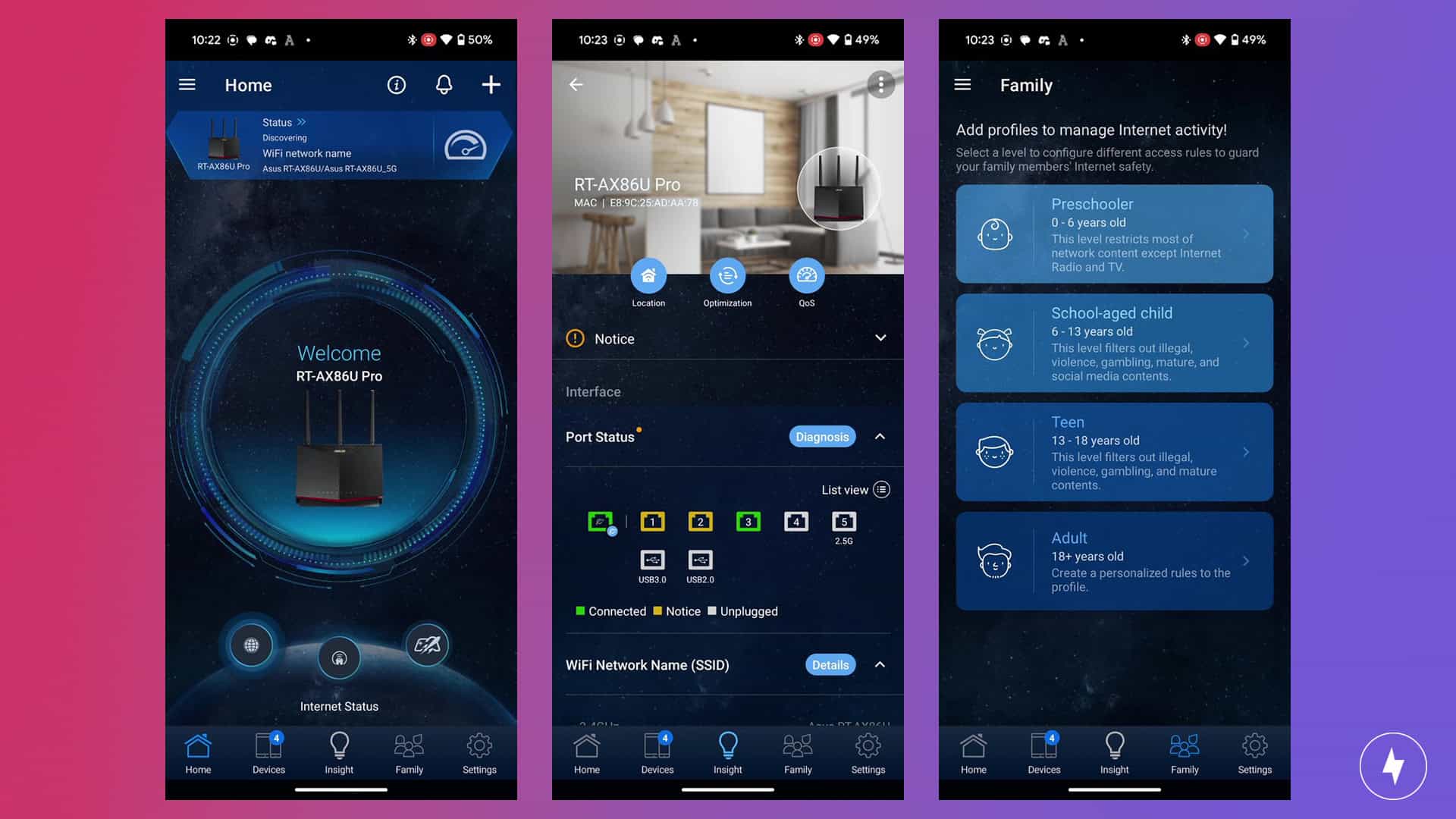
The Asus Router app was much more advanced than what I’m used to, and it’s clear it’s primarily made for power users. The homepage has a convenient traffic visualizer that quickly breaks down the network’s real-time performance. You can also enable Mobile Game Mode from the homepage.
The app gets complicated once you jump into the Settings tab, however, where settings are tucked away like nesting dolls. I had a hard time finding everything initially, but I came to appreciate the amount of features offered. You can set up QoS, enable a bandwidth limiter, set parental controls, adjust security settings, and even inspect the LAN ports, which is how I learned I was using outdated 100 Mbps Cat 5 Ethernet cables on two of the LAN ports.
For those who want a more streamlined experience, the Asus Router app has an Insights tab that gives you the main takeaways to keep your network and router running at top performance. I found firmware updates, remote connection settings, port statuses, and security settings — everything you need for the best router experience.
I don’t have kids in my home, but I appreciated that the Asus RT-AX86U Pro came with a full selection of parental controls even though the router is oriented toward gamers. The Family tab allows you to customize profiles for up to four age groups, from preschoolers and school-aged children to teens and beyond. If you have children, you can limit their internet access or even award additional time for good behavior. The router also comes with Asus Safe Browsing technology, so you can filter content, block malicious websites, and keep ads away from your family’s browsing experience.
The Best Router for You: Do you like the Asus RT-AX86U Pro, but you’re still determining if it fits your home best? Check out our list of the best Wi-Fi routers of 2024 for more of this year’s top picks.
Asus RT-AX86U Pro Performance: Impressive Real-World Results
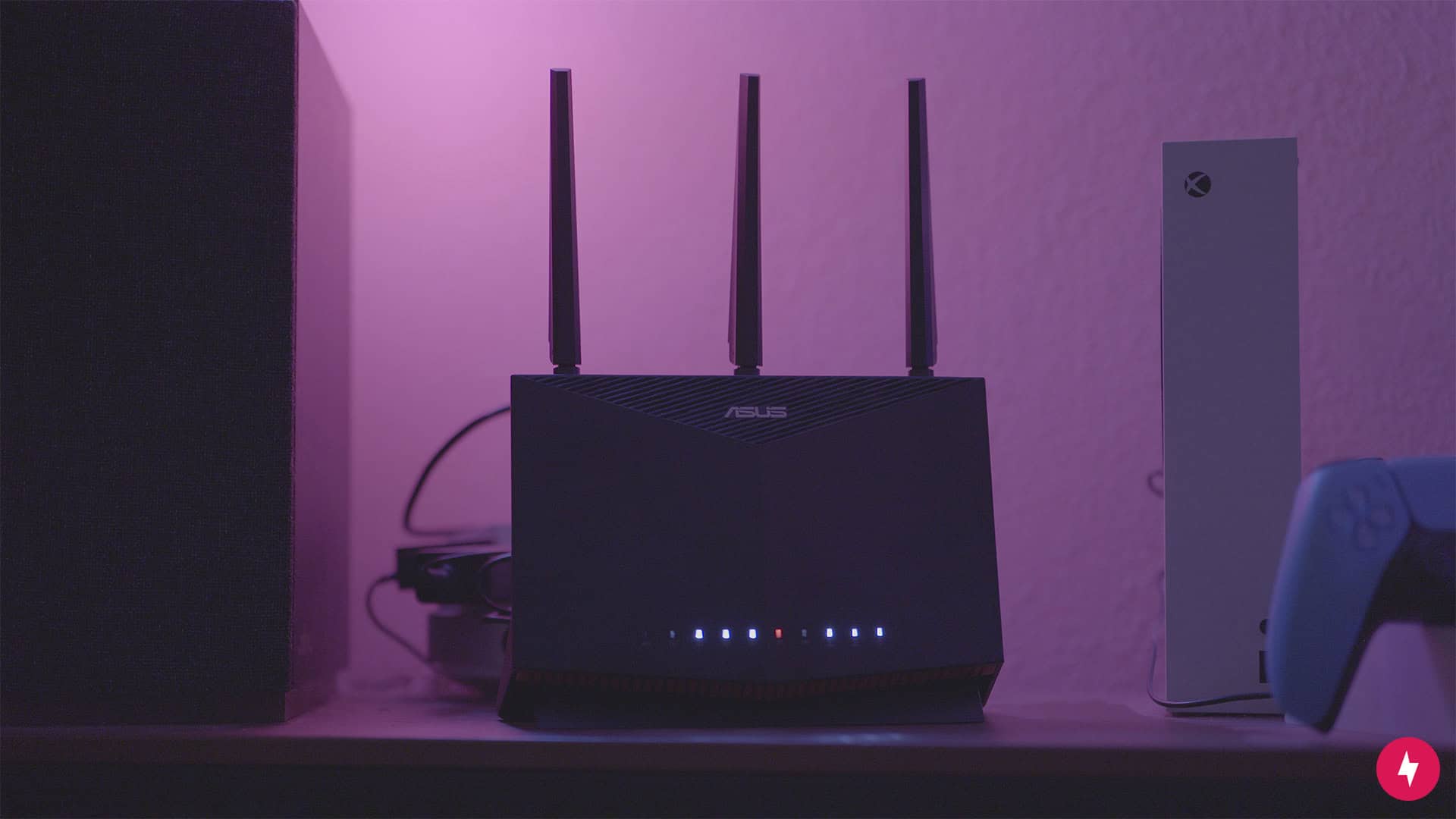
Now for my favorite part of testing routers: performance. I tested the Asus RT-AX86U Pro on a 1 Gbps Google Webpass connection using my Google Pixel 6 smartphone. Since it has Wi-Fi 6 built in, it is more than equipped to handle anything this router could throw at it. I conducted each test in my 700-square-foot, one-bedroom apartment, where I tested the router multiple times from its spot in the living room to the closet behind two walls on the farthest edge of the apartment.
Testing the Router

My Wi-Fi speeds using Google Webpass tend to fluctuate, even on a phone with Wi-Fi 6, so I don’t regularly get connection speeds above 800 Mbps on my current Netgear Nighthawk router. That said, at the closest distance from the router, I achieved download speeds of up to 888 Mbps and upload speeds of up to 938 Mbps.
In the same room, at a distance of 15 feet, the speeds dropped by about 6 percent — not a major decrease in effectiveness. The most significant dip I experienced was at the farthest edge of the apartment behind two walls. I saw download speeds as low as 505 Mbps, or a 57 percent speed decrease. Even though that’s a substantial drop, I still had a consistent connection to the router and I think most people will have the router positioned closer to gaming devices rather than farther away.
Testing in a vacuum is one thing, but real-world benchmarking should hold more weight. That’s why I downloaded “Alan Wake 2” onto an Alienware M18 laptop over a Wi-Fi 6 connection. At a size of 84 GB, I could download the game in a quick 17 minutes on Steam, averaging speeds between 600 and 680 Mbps. Server-side speeds can be a factor in that type of test, of course, but it shows how the Asus RT-AX86U Pro can power through even large downloads without an Ethernet cord.

I also tested Mobile Game Mode on the Asus RT-AX86U Pro to get an idea of the router’s more advanced features. This feature prioritizes mobile gaming traffic above all else at the click of a button. In larger households with constant bandwidth-usage issues, the feature has the potential to be a game-changer. In my testing, however, I didn’t find much use for it, since only two of us share a 1 Gbps network. When playing “Fortnite” with Mobile Game Mode activated, I didn’t notice any improvements over my standard gameplay experience, which was already very good.
Unless multiple 4K streams are happening simultaneously in your household, you probably won’t notice a major performance boost from turning on Mobile Game Mode. If anything, turning on Mobile Game Mode could negatively impact other network users.
Comparing to Competitors
We found the Asus RT-AX86U Pro to be a strong performer, especially when it’s positioned in proximity to the most bandwidth-hungry devices in your household. Based on our internal tests, the Asus RT-AX86U Pro even outperformed the eero 6+ and TP-Link AX55 when it came to transmitting a signal through multiple barriers, such as walls and floors. It doesn’t have the 6 GHz channel speeds of the TP-Link AXE75 or its bigger Wi-Fi 6E brother, the Asus RT-AXE7800, but the Asus RT-AX86U Pro brings plenty of effectiveness for almost every activity.
Our Verdict: Ideal for Gamers and Everyday Users Alike

If you already own the original Asus RT-AX86U, we don’t think there is a huge reason to upgrade to the Pro version. If you’re deciding on a new Wi-Fi 6 router that will last numerous years, however, the upgraded internal hardware and additional features of the Asus RT-AX86U Pro make it a great fit for everything you need, from gaming online and streaming 4K TV to working from home and uploading large files.
The setup was a little finicky, the configuration was a tad overwhelming, and the performance could have been a bit better overall, but I was impressed by the entry-level gaming router. For the price, the Asus RT-AX86U Pro delivers an exceptional experience compared to other routers with similar technology and features. The Asus RT-AX86U Pro sits squarely in the middle between users who want to set it and forget it and those who like to pore over the details. If you’re the latter type of user and want to upgrade to something more powerful and customizable than your current router, the RT-AX86U Pro offers a high-end experience at an entry-level price.
How We Assess Routers
When we assess routers, we always attempt to scrutinize them equally for each review. That’s why our team of tech testers uses the key factors below to guide them through the process.
- Specs: We meticulously inspect a wide range of router components, including wireless standards such as Wi-Fi 6, Wi-Fi 6E, and Wi-Fi 7, as well as CPU and RAM specifications. That comprehensive analysis allows us to gauge whether a router aligns with current standards and enables us to conduct comparative evaluations with other models.
- Setup: Unlike routers of the past, today’s routers should be easy to install and intuitive for the user. Saving time configuring your router means you can start using it sooner. That’s why we look at the setup duration and intensity for each router with a focus on expediency. We also get hands-on with the apps associated with each router to see how easy they are to navigate and in what ways they can make router ownership easier.
- Price: Everyone has a budget, and routers can range from $50 to well over $500 for a single device. When we review a router, we consider the initial cost, as well as any potential fees or add-ons you may have to purchase to get the full functionality out of your router. We also compare prices among brands and models, with a focus on limited-time deals and price cuts.
- Performance: The best routers get the most out of your internet plan speeds. They also are able to handle a wide range of necessities, including different home sizes, various activities, and a multitude of devices. We run each router through a series of hands-on tests from varying distances and on different devices to see how they perform in real-world situations.
- Value: After weighing price, performance, ease of setup, and technology, we arrive at a router’s overall value. Value is a balancing act. We expect higher performance from more expensive routers, while cheaper routers may naturally have lesser results in speed tests. Our favorite routers combine a reasonable price with exceptional results during testing to deliver a fulfilling experience for a long time.